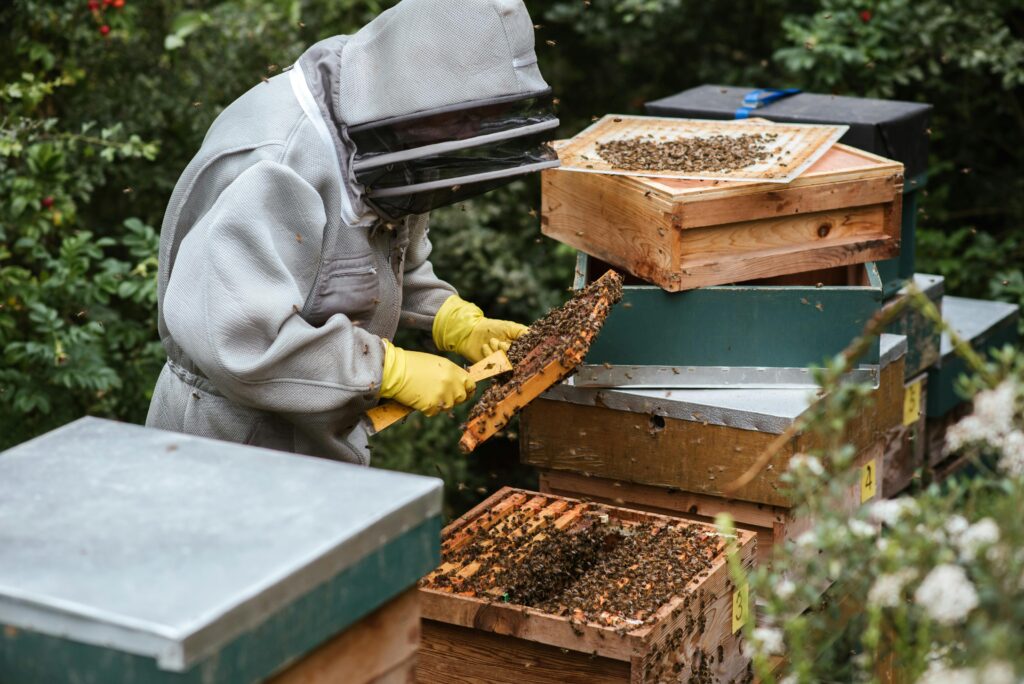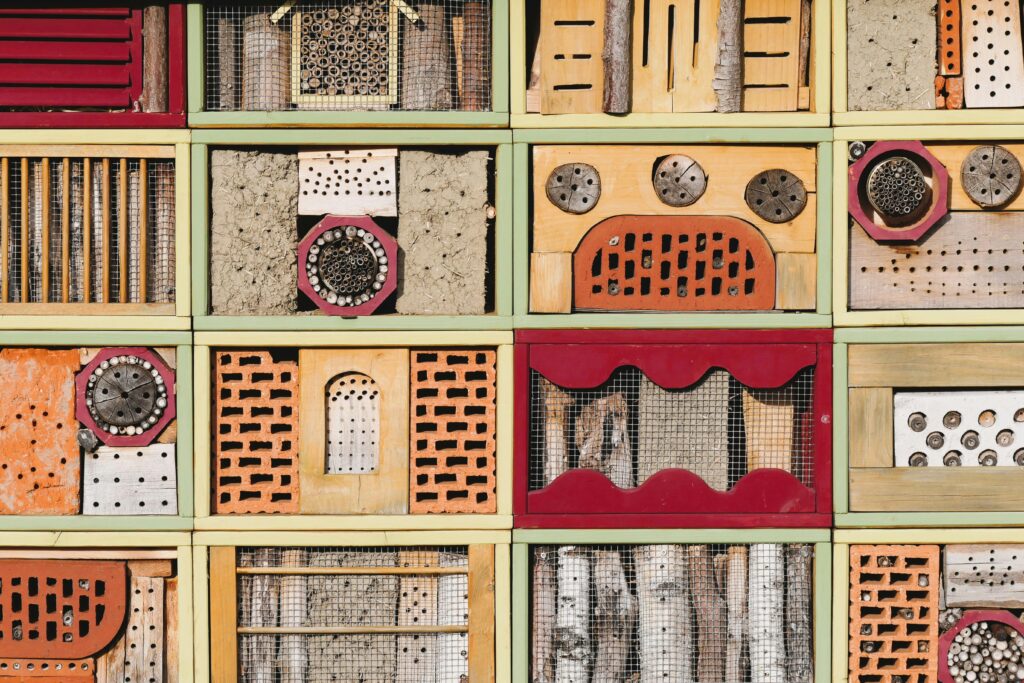
Waking up to the hum of bees in the garden is magical. Beekeeping is more than a hobby for me; it’s a way to connect with nature and help the planet. When I started building my own bee hive, I created a place of life and harmony.
Building your own beehive lets you explore beekeeping and make a positive impact. Learning to build a beehive is rewarding. It’s a chance to help our ecosystem.
Key Takeaways
- Discover the joy and sustainability of backyard beekeeping.
- Learn the essentials of how to build a beehive for your garden.
- Understand the critical role of bees in our ecosystem.
- Experience the fulfillment that comes with constructing bee boxes.
- Create a harmonious backyard apiary that benefits both you and nature.

Introduction to Beekeeping
Starting your beekeeping journey is both thrilling and fulfilling. This beginner beekeeping guide will cover the basics of beekeeping. We’ll explore the roles in a bee colony and the life cycle of bees.
Knowing the roles in a bee colony is key for new beekeepers. A colony has a queen bee, worker bees, and drones. The queen lays eggs. Worker bees, all female, do tasks like gathering nectar and caring for young. Drones, the males, mate with the queen.
The lifecycle of bees starts with the queen laying eggs. These eggs turn into larvae, then pupae, and finally adult bees. They’re ready to help the colony thrive.
Beekeeping is more than a hobby; it’s crucial for our ecosystem. Bees pollinate plants, which is key for growing fruits, veggies, and seeds. By beekeeping, we support the bee population and help our environment.
Beekeeping comes with important duties. You’ll need to check the hive often, manage diseases, and make sure bees have food and water. With good bee hive plans, you can create a great home for your bees. This leads to honey and other bee products.
Importance of a Good Hive Location
Choosing the right spot for your bee hive is key for your bees’ health and success. A good location means your bees can thrive, make honey well, and stay safe from dangers.
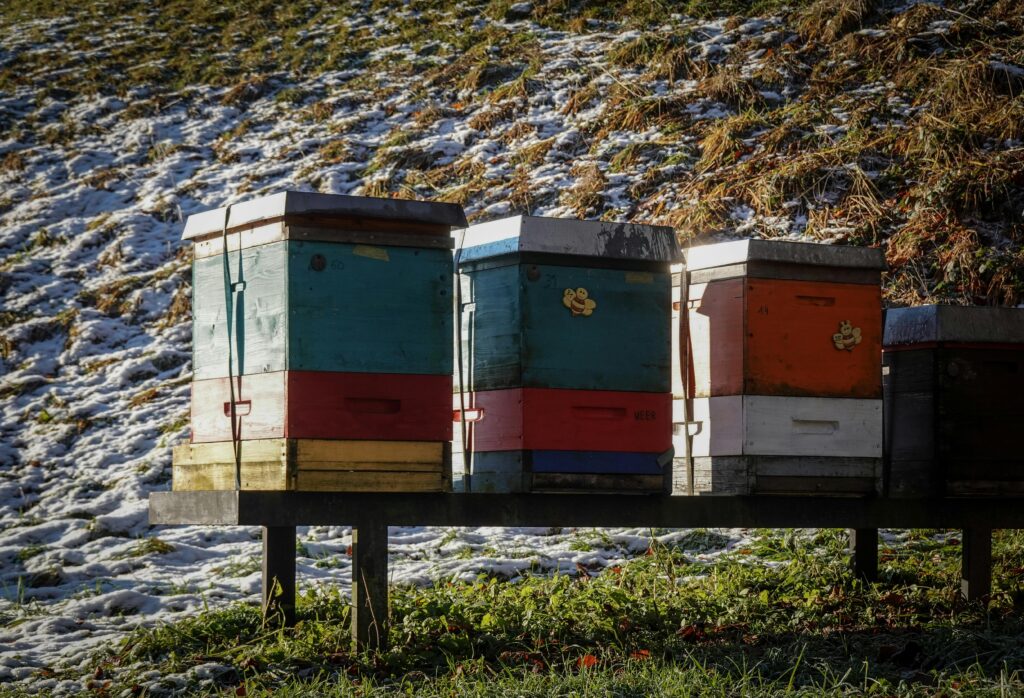
Factors to Consider
When picking a spot for your hive, think about a few important things. These include:
- Sun Exposure: Put your hive where it gets morning sun. This helps bees start their day early.
- Wind Protection: Your hive needs to be safe from strong winds. A fence or shrubs around it can help.
- Proximity to Water: Make sure there’s water close by. Bees need it to drink and cool their hive.
- Foraging Areas: Put your hive near flowers or gardens. This lets bees easily find nectar and pollen.
Common Mistakes to Avoid
Staying away from common mistakes is crucial. Here are some to watch out for:
- Footpaths Proximity: Don’t put hives near busy paths. It can disturb the bees and might cause stings.
- Ignoring Local Wildlife: Keep the area safe from pests like skunks and raccoons. Use protective measures if needed.
- Poor Drainage Areas: Don’t choose spots that flood. Make sure the hive stand is high to avoid water problems.
By carefully planning and considering these points, you can make great bee hive plans. This will help your bees do well and make your beekeeping rewarding.
Choosing the Right Hive Type
When you start beekeeping, picking the right hive is key. The hive type you choose affects your success, comfort, and how well you manage the bees.
Langstroth Hives
Langstroth hives are very popular in beekeeping today. They have a design with removable frames that makes checking on the bees easy. If you’re new to beekeeping and want to know how to build a beehive, Langstroth hives are a good choice.
These hives are great for making lots of honey. They work well for both hobbyists and commercial beekeepers. Building a Langstroth hive is rewarding and helps your bees grow strong and healthy.
Top-Bar Hives
Top-Bar hives are simple and follow a natural beekeeping approach. They have horizontal bars at the top of a single box for the bees to build their comb. If you prefer a simple way to build a beehive, Top-Bar hives are perfect.
They let you get close to the bees and understand their behavior better. While they might not make as much honey as Langstroth hives, they offer a sustainable beekeeping experience. The right beekeeping equipment plans make working with Top-Bar hives enjoyable.
Both hive types have their own benefits and things to consider. Your choice depends on your beekeeping goals and the environment you’re in.
Essential Beekeeping Equipment
Starting your beekeeping journey requires the right equipment. Detailed plans help you set up a safe and productive apiary. This section will cover the tools, protective gear, and hive components you need.
Tools and Protective Gear
You’ll need various tools and protective gear to manage your beehive. A smoker, hive tool, and protective suit are must-haves. The smoker calms bees during inspections, making it safer. The hive tool helps with prying frames, and the suit protects you from stings.
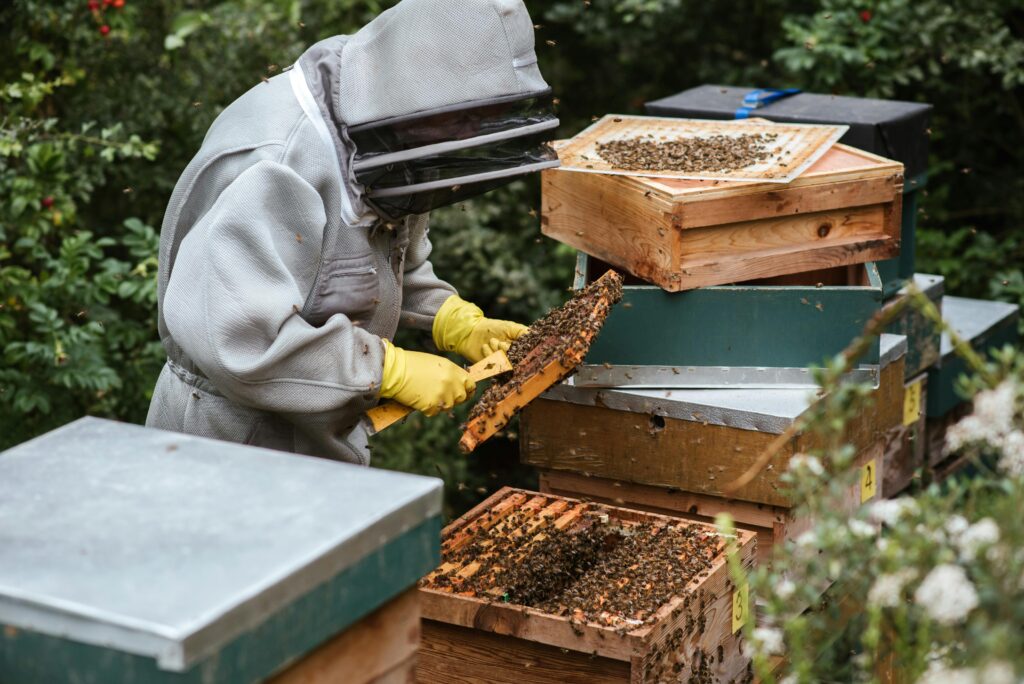
Beekeeping Tools Starter Kit

9 Pcs Beekeeping Tools Kit with Organizer Tote for Beekeepers, Necessary Beekeeping Supplies Bee Keeping Starter Kit Includes Bee Smoker Kit and Beehive Tools, click here for details
- Smoker: Used to calm bees by producing smoke that masks their alarm pheromones.
- Hive Tool: A versatile tool for scraping, prying, and lifting hive components.
- Protective Suit: Includes a veil, gloves, and a full-body suit to protect against bee stings.
Hive Components
Knowing the basic hive components is key for bee box construction and colony health. Frames, foundation, and covers are essential. Frames give bees a structure for comb building, while foundation guides them. Covers protect the hive from weather and pests.
| Component | Description |
|---|---|
| Frames | Provide a structure for bees to build their comb and store honey. |
| Foundation | Guides bees in constructing comb within the frames. |
| Covers | Protects the hive from weather and pests, ensuring the colony’s safety. |
By using these tools and components in your plans, you’ll have a successful beekeeping experience. Good planning and understanding these essentials will help you build a thriving apiary. This makes building bee boxes easier and more rewarding.
Understanding Bee Behavior
In a beginner beekeeping guide, knowing how bees act is key to keeping a healthy hive. Bees show different behaviors that tell us how the hive is doing.
Swarming is a big sign of change. It happens when a hive gets too big. Then, the old queen and many worker bees leave to start a new home. Spotting swarming signs early lets me stop it from happening.
Foraging is also important. Bees go out to find nectar, pollen, and water. Watching where they go helps me see if the hive is getting what it needs.
Defending the Hive is a natural bee instinct. When the hive feels threatened, bees get ready to fight. They might sting more and have more guard bees at the door. Knowing this helps me keep the hive safe without stressing the bees too much.
Knowing about these behaviors is crucial for a beginner beekeeper. By watching these signs, I can make smart choices to keep my hive thriving. It’s all about stopping swarming, making sure bees forage well, and keeping the hive safe. Understanding bee behavior is a must-have skill for beekeepers.
Step-by-Step Guide to Bee Hive Plans
Building a DIY bee hive is rewarding and saves money. This guide will help you from start to finish. You’ll learn how to make a safe and productive hive for your bees.
Materials Needed
First, gather all the materials you need. Here’s what you’ll require:
- Wood boards (cedar or pine are recommended)
- Table saw or circular saw
- Screws and nails
- Wood glue
- Protective sealant
- Paint (optional for aesthetics)
- Protective gear (gloves, goggles)
- Tape measure
Make sure you have these materials ready. Using quality wood like cedar helps the hive last longer and protect the bees better.
Construction Process
Building a bee hive requires careful steps for a working hive:
- Cutting the Wood: Cut the wood boards with a table saw or circular saw. A Langstroth hive needs many boxes and frames.
- Assembling the Boxes: Assemble the boxes with nails and wood glue. Make sure the corners are right for a strong structure.
- Constructing the Frames: The frames are key for the bees to build combs. Cut and join wood pieces for the frames, placing them evenly.
- Adding the Bottom Board and Cover: Attach a bottom board and a cover. Make sure there are gaps for air.
- Seal and Paint: Seal the exterior and paint if you like. This protects the hive from weather.
By following these steps, you’ll have a strong and good-looking DIY bee hive. It’s important to learn how to build a beehive right for your bees’ health and productivity. Check out “The Backyard Beekeeper” by Kim Flottum and local beekeeping clubs for more help.
Maintenance and Management Tips
Keeping your bee colony healthy and productive is key. Regular care of your bee hive plans and using good beekeeping equipment plans is essential. This will help your apiary thrive.
Regular Inspections
Common Hive Issues and Solutions
Many issues can affect hives, but you can manage them with the right steps. Here are some common problems and how to solve them:
Checking your hives regularly is crucial. I suggest inspecting them every one to two weeks when they’re active. Look for signs of disease, pests, and hive activity. Keep a record of your findings to track changes and spot problems early.
| Issue | Symptoms | Solutions |
|---|---|---|
| Varroa Mites | Deformed wings, mites on bees | Introduce mite-resistant bees, use miticides |
| Mold | Discolored comb, moisture in the hive | Improve ventilation, reduce humidity |
| Hive Beetles | Beetles seen in and around hive | Use beetle traps, maintain strong bee colony |
By following these maintenance tips and using the right beekeeping equipment plans, you can tackle common hive issues. This will help you manage your beekeeping operation effectively.
Urban Beekeeping Blueprints
Urban beekeeping brings its own set of challenges and chances. It involves setting up bee colonies in cities carefully. This means considering space and local laws.
Adapting to Urban Environments
Space is a big deal in cities. Rooftops, balconies, and small yards need creative solutions. Vertical hives and modular kits help make the most of limited space.
Local rules are also important. Cities have their own rules for beekeeping. Knowing these rules helps avoid fines and helps the community. Joining local beekeeping groups can offer great advice and support.
Planting bee-friendly plants is key in cities too. Balconies and gardens can become bee magnets with the right plants. Native plants are especially good because they need less care and help local bees.
It’s also important to think about neighbors. Teaching them about the good of bees can build good will. Events like open-hive days or bee workshops can help explain beekeeping and get people on board.
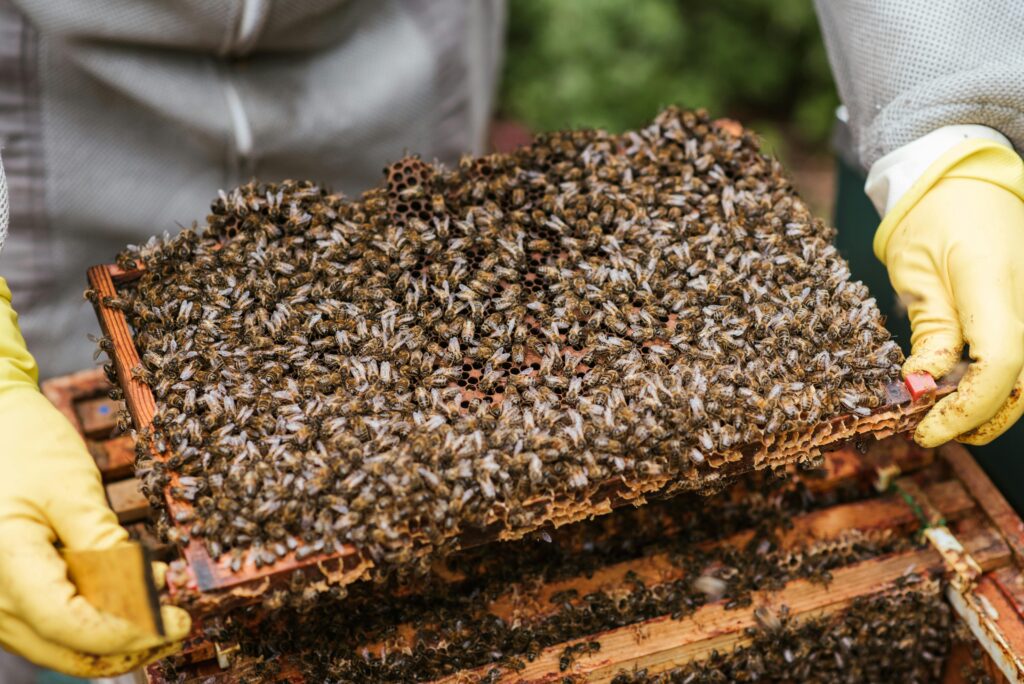
DIY Bee Hive and Cost Savings
Building your own bee hive is rewarding and saves money. It lets you tailor the hive to your beekeeping needs. A diy bee hive in your backyard cuts costs and deepens your bond with bees.
Budget-Friendly Beekeeping
Start a budget-friendly beekeeping project with household items and recycled materials. This method cuts costs and supports sustainability. You can use wooden pallets, old wine boxes, and crates to make a bee hive.
Also, buying second-hand tools and equipment saves money. This way, you keep your beekeeping setup efficient without spending a lot.
- Source Recycled Materials: Wooden pallets and wine boxes are excellent options.
- Construct Hive Components: Use household tools to build brood boxes and supers.
- Acquire Affordable Protective Gear: Explore second-hand stores or online marketplaces for used beekeeping suits and tools.
This approach balances cost savings with effectiveness. It makes budget-friendly beekeeping possible for more people. By turning everyday items into a diy bee hive, you save money and start a fulfilling project that helps your local ecosystem.
Free Bee Hive Designs
Getting free bee hive designs is great for both new and seasoned beekeepers. Many places have detailed plans, lists of materials, and easy-to-follow steps. These help you build your own hives that are both useful and affordable.
The Spruce has a big collection of free bee hive designs for beginners. You’ll find plans for Langstroth, Top Bar, and Warre hives. Each plan comes with clear instructions, a list of materials, and step-by-step help to build your hive1. Beekeeping 101 also has 35 free DIY beehive and accessory plans. These plans range from the Long Langstroth Beehive to the Mini Nucleus Hive, each with its own special features and building methods2. The Layens Hive is another popular choice, known for its horizontal design and deep frames. It’s perfect for keeping bees through winter and helping them grow fast in spring3.
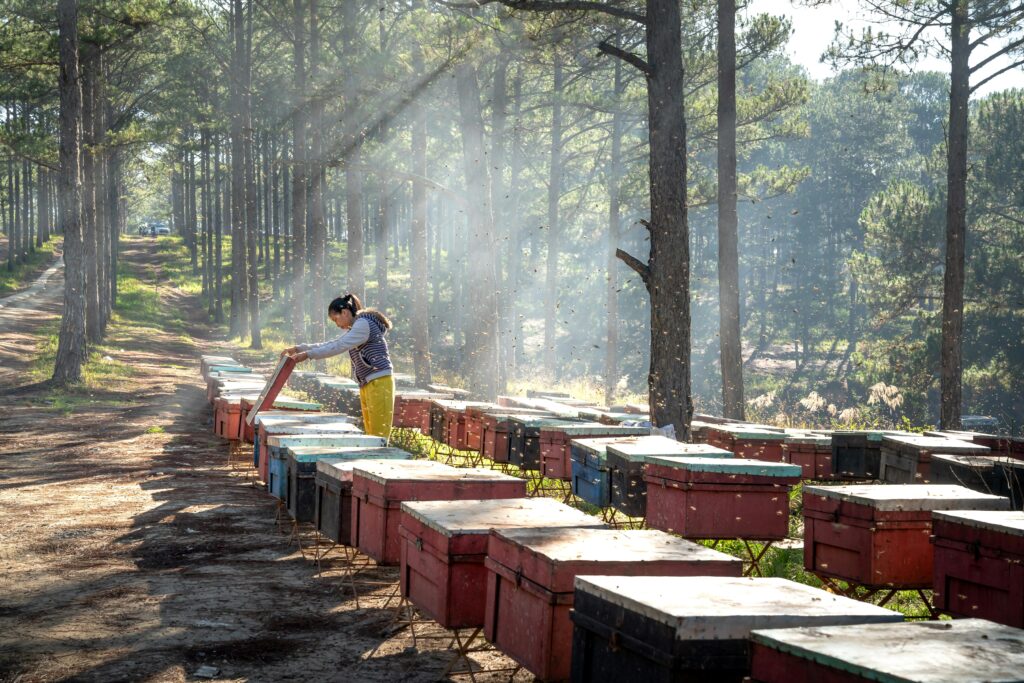
Accessing Free Plans and Resources
Many online sites and beekeeping groups offer great resources for starting or improving your beekeeping. For example, The British Beekeeping Association and the Natural Beekeeping Trust help urban beekeepers. They provide support, education, and a community for natural beekeeping4. These groups focus on keeping bees healthy and productive.
Advanced Beekeeping Techniques
Advanced beekeeping techniques are key, especially queen rearing. This method involves breeding queens for traits like disease resistance and honey production. Learning this can greatly boost your hive’s health and output.
Hive splits are another critical technique. It means splitting a strong hive into two or more. This helps prevent swarming and grows your bee population. To do it right, you need to know the hive’s inner workings and make sure each new hive has what it needs.
Integrated pest management (IPM) is also essential. It uses various methods to fight pests and diseases, avoiding chemicals. IPM includes regular checks, keeping the hive clean, and using natural controls like mites. It helps keep your hive balanced and pest-free.
Using these advanced techniques can make your beekeeping top-notch. Your hives will stay healthy and productive for years. For more info, check out Dr. Thomas Seeley’s work and the American Beekeeping Federation.
Harvesting Honey from Your Backyard Apiary
Harvesting honey is a rewarding part of beekeeping. Knowing when and how to do it is key for quality and yield. New beekeepers find joy and pride in this detailed process.
When to Harvest
Harvesting honey at the right time is important. Honey is ready when 80% of the cells are capped. This means the honey is dry enough to prevent spoilage. Watch your bees and don’t take too much honey, as they need enough for winter.
Processing and Storing Honey
When it’s time to harvest, make sure you have the right tools. After getting the honeycombs, extract the honey. You can use a manual or electric extractor. Then, strain the honey through a fine mesh to get rid of impurities and wax.
Store the honey in airtight glass jars to keep its natural flavors and nutrients. Keep it in a cool, dry place, away from sunlight. This way, your honey will stay fresh and tasty for a long time.
| Stage | Process | Key Tips |
|---|---|---|
| Harvesting | Collect honeycombs when 80% of cells are capped | Ensure bees retain enough honey reserves for winter |
| Processing | Use an extractor and strain honey | Remove impurities and wax particles |
| Storing | Store in airtight glass jars | Keep in a cool, dry place away from sunlight |
By following these steps, harvesting honey from your backyard apiary will be a rewarding and fun experience.
Conclusion
Beekeeping is a rewarding hobby that benefits both the beekeeper and the environment. By building bee boxes and learning from this guide, you can start a fulfilling journey. This journey supports bee populations and boosts biodiversity.
Having a thriving apiary in your backyard is incredibly rewarding. It connects you to nature’s rhythms and lets you enjoy home-harvested honey.
In this article, we’ve covered essential topics for starting beekeeping. We talked about choosing the right hive location and type. We also explored bee behavior and advanced techniques.
Each section aimed to give you the knowledge needed to succeed in beekeeping. This way, beginners can move forward with confidence.
Reflecting on this guide, remember that beekeeping helps our ecosystems. By using the information provided, you join a movement towards sustainability. Happy beekeeping, and may your apiary grow!
FAQ
What are the essential components of a bee hive?
Key parts include frames, foundation, and covers. You also need a bottom board and hive bodies. Each part is vital for the hive’s structure and function.
Why is the location of my hive important?
The right spot ensures bees get sunlight, water, and food. It should also protect them from strong winds. Avoid areas near footpaths or wildlife.
What are the main differences between Langstroth and Top-Bar hives?
Langstroth hives are traditional and structured, making them easier to manage. Top-Bar hives are simpler and better for natural beekeeping.
What equipment do I need to start beekeeping?
You’ll need a protective suit, smoker, and hive tool. Frames and foundation are also essential for managing your hive safely.
How does understanding bee behavior help in managing hives?
Knowing about swarming, foraging, and defense helps you manage issues. It keeps your hive healthy for your bees.
How do I construct a beehive from scratch?
Start by gathering wood, nails, and tools. Follow a guide for dimensions and assembly. This will help you build a strong, functional hive.
What are common hive issues and how can I manage them?
Issues include mites, mold, and beetles. Regular checks and management strategies, like integrated pest management, can keep your hive healthy.
What challenges do urban beekeepers face?
Urban beekeepers deal with space, regulations, and limited foraging. But, with planning and local law compliance, it can be rewarding.
How can I save costs when building a bee hive?
DIY and use recycled materials to cut costs. Free plans and resources can also help you save money.
Where can I find free bee hive designs?
Look online for free designs and plans. Resources like the Bee Informed Partnership and American Beekeeping Federation are great places to start.
What advanced beekeeping techniques should I consider?
Experienced beekeepers might try queen rearing, split techniques, and integrated pest management. These can improve your skills and hive productivity.
When is the best time to harvest honey?
Harvest honey in late summer to early fall. Check for capped honeycomb to know it’s ready.
How should I process and store honey?
Filter honey to remove impurities. Store it in airtight containers at room temperature. This keeps its natural taste and quality.
Source Links
- https://www.thespruce.com/free-bee-hive-plans-5078043
- https://beekeeping101.com/diy-beehive-plans/
- https://layenshive.com/how-to-build/layens-beehive-design.shtml
- https://www.ft.com/content/5dd46b88-9c14-46ee-bdba-11f2c211b761
Or if you’d rather just buy a Bee Hive…
Mason Bee House
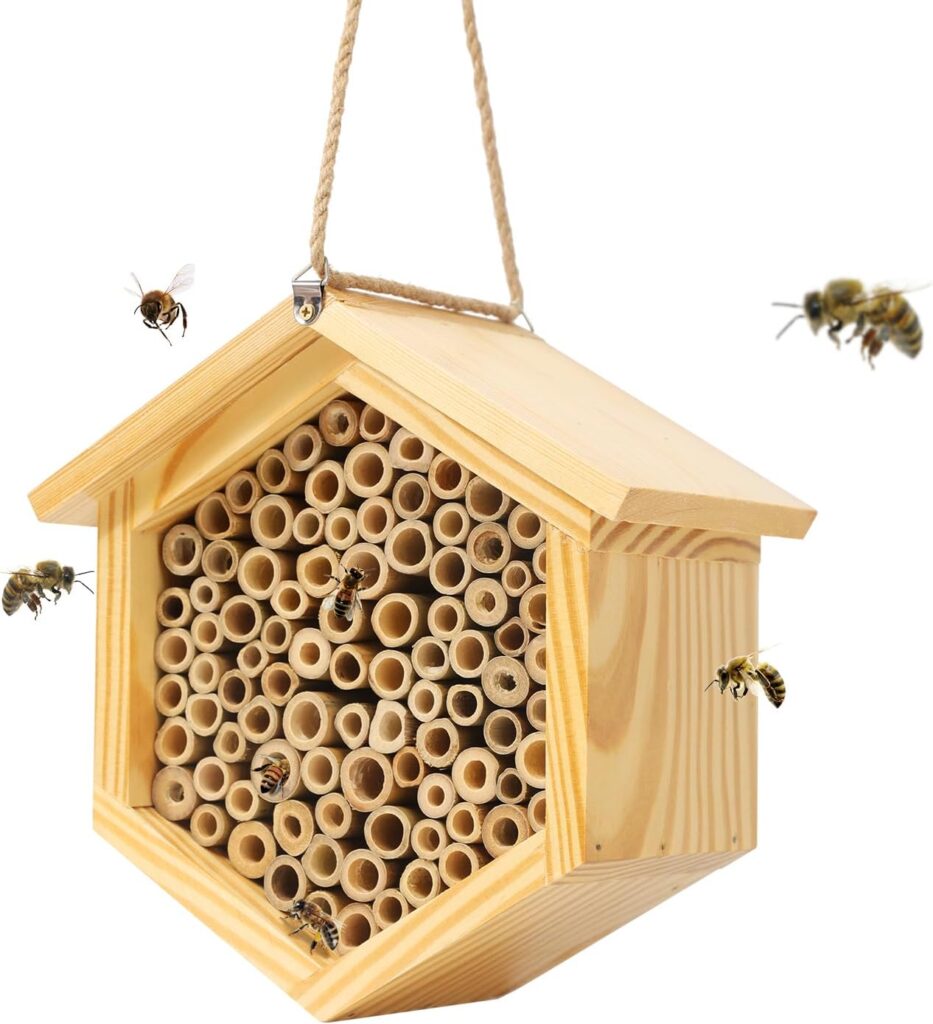
Mason Bee House Native Bee Hive Hexagon Bee House Natural Handmade Wooden Mason Bee Box Habitat Home Hotel with Bamboo Tubes click here for details
Hoover Hives: The Original Beeswax Coated Beehive Kit
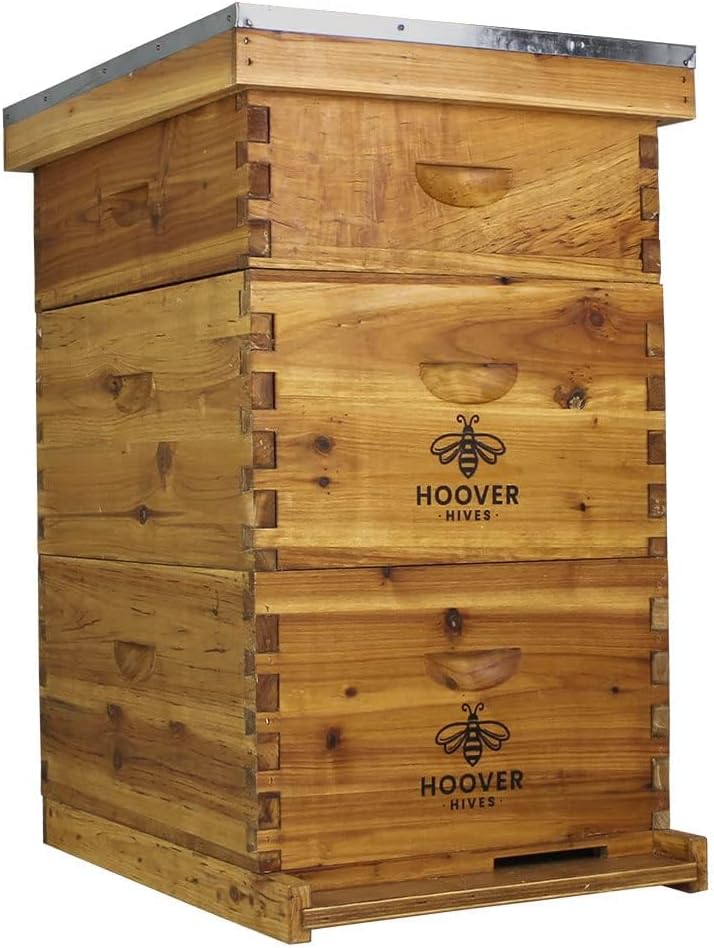
Includes 2 Deep & 1 Medium Boxes with 10 Wooden Frames & Heavy Wax Coated Foundations. Easy Assembly with Predrilled Holes& Screws (Unassembled) click here for details
Mann Lake Traditional Complete 10-Frame Bee Hive Kit
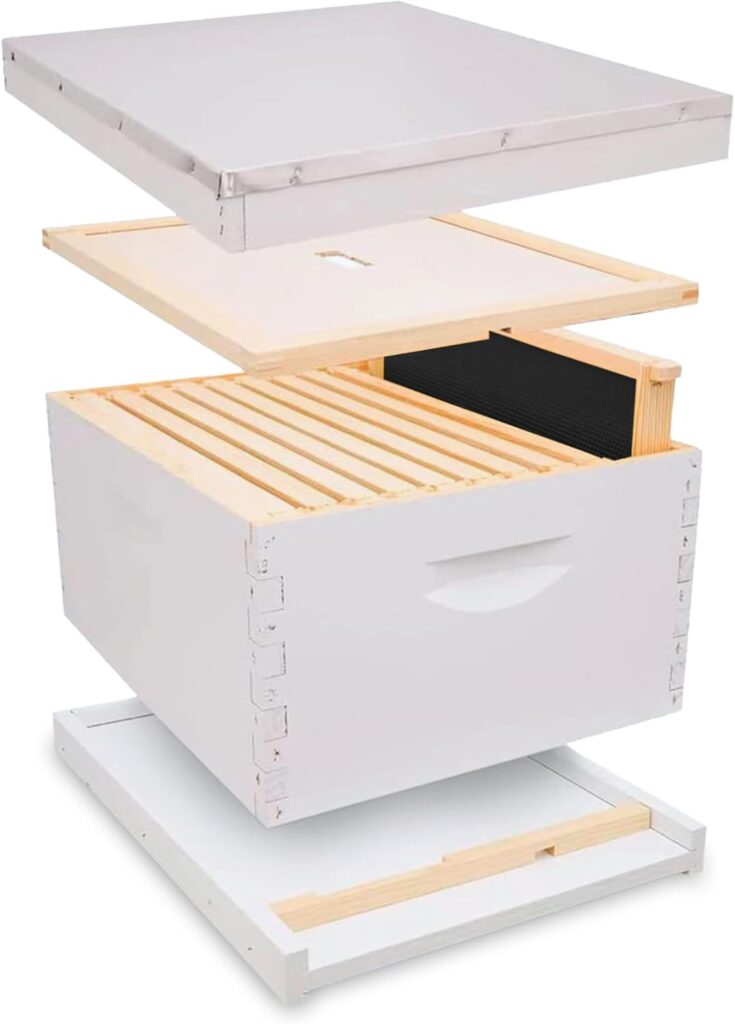
Traditional Complete 10-Frame Bee Hive Kit, Fully Assembled 9⅝” Deep Hive Body with 10 Frames, Beeswax-Coated Foundation, Telescoping Cover, Bottom Board & Reducer, Made in USA, click here for details
Longads Beekeeping Suit

Professional Bee Suit for Men Women, Beekeeping Suit Beekeeper Suit with Glove &Ventilated Hood, Multi-Size Bee Outfit for Backyard and Bee Keeper click here for details
Photo Credits: I want to thank the amazing photographers whose work we used in this article, these pros are on Pexels where you can also get royalty free photos for your posts, please visit their sites today just click on their names or their photos below: Michaela St, Anete Lusina, Magda Ehlers & Quang Nguyen Vinh



